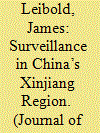| Srl | Item |
| 1 |
ID:
165142


|
|
|
|
|
| Summary/Abstract |
This article contributes to the discussion about China's divisive influence on the Association of Southeast Asian Nations (ASEAN). It argues that recent China–ASEAN relations are based on Beijing's successful implementation of a dual strategy of coercion and inducement. The effectiveness of this strategy is tested against the South China Sea disputes – the issue that lies in the core of regional security and a key platform of power display. The article outlines Beijing's recent interaction with individual ASEAN member-states and its implications for the regional multilateral diplomacy. While by no means identical, Beijing's dual strategy of coercion and inducement with individual ASEAN states have resulted in an effective abuse of the ASEAN consensus principle – a tactic often referred to as ‘divide and rule’. Consequently, the group's internal discord has further eroded and affected the institutional confidence of ASEAN. This article draws attention to the psychological effect of coercion as a perception of punishment, and inducement as a perception of reward.
|
|
|
|
|
|
|
|
|
|
|
|
|
|
|
|
| 2 |
ID:
173934


|
|
|
|
|
| Summary/Abstract |
Over the last decade, the Chinese Communist Party has built an unprecedented surveillant assemblage in the Xinjiang Uyghur Autonomous Region (XUAR) with the region’s Uyghur Muslim minority as the chief target of augmented Party-state controls. This article interrogates the mechanics, logic and implications of Xinjiang’s surveillance society. It demonstrates how Party-state monitoring comes not only in the form of physical monitoring and forced kinship but also automated, technology-driven tools such as GPS tracking, voice and facial recognition technologies, machine learning algorithms, and other software and hardware. The Chinese Party-state employs surveillance to delineate ‘correct’ thought and behaviour among its citizens, and then persuade (through coercion and inducement) self-alignment with Party and Han-defined norms. The results are fewer spaces for autonomous, bottom-up social mobilization by the Uyghurs and other minorities, the abolition of non-Han cultural, linguistic and religious practices, and the erosion of social trust in Xinjiang society.
|
|
|
|
|
|
|
|
|
|
|
|
|
|
|
|